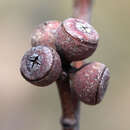en
names in breadcrumbs


Eucalyptus arenacea, commonly known as the desert stringybark[3] or sand stringybark,[4] is a tree or a mallee that is endemic to south-eastern Australia. It has rough bark to the thinnest branches, lance-shaped or curved adult leaves, club-shaped flower buds arranged in groups of between seven and fifteen, white flowers and hemispherical to more or less spherical fruit.
Eucalyptus arenacea is a tree with several to many stems or a robust mallee, grows to a height of 3–10 metres (10–30 ft) and forms a lignotuber. It has rough, fibrous and stringy bark on its trunk and to the thinnest branches. Leaves on young plants and on coppice regrowth are arranged in opposite pairs and are egg-shaped, 35–85 mm (1–3 in) long and 30–40 mm (1–2 in) wide. Adult leaves are shiny green, arranged alternately, lance-shaped or curved, 70–120 mm (3–5 in) long and 15–40 mm (0.6–2 in) wide on a petiole 10–25 mm (0.4–1 in) long. The flowers are borne in groups of between seven and fifteen in leaf axils on a peduncle 5–18 mm (0.20–0.71 in) long, the individual buds on a pedicel 2–5 mm (0.079–0.20 in) long. The mature buds are oval to club-shaped, 5–6 mm (0.20–0.24 in) long and 3–5 mm (0.1–0.2 in) wide with a rounded or conical operculum. Flowering mainly occurs between December and January and the flowers are white. The fruit is hemispherical to a truncated sphere, 4–9 mm (0.16–0.35 in) long and 7–12 mm (0.3–0.5 in) wide on a pedicel up to 3 mm (0.1 in) long.[3][4][5]
Eucalyptus arenacea was first formally described in 1988 by Julie Marginson and Pauline Ladiges and the description was published in Australian Systematic Botany.[6] The specific epithet (arenacea) is a Latin word meaning "of sand".[7]
Desert stringybark grows on pale-coloured sandhills and on sandplains between Keith, Pinaroo and Bordertown in the Ninety Mile Desert in South Australia and in the Little Desert and Big Desert areas of Victoria.[4][5]
Eucalyptus arenacea, commonly known as the desert stringybark or sand stringybark, is a tree or a mallee that is endemic to south-eastern Australia. It has rough bark to the thinnest branches, lance-shaped or curved adult leaves, club-shaped flower buds arranged in groups of between seven and fifteen, white flowers and hemispherical to more or less spherical fruit.
 flowers and buds
flowers and buds fruit
fruit